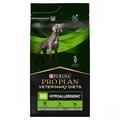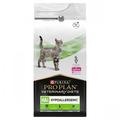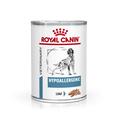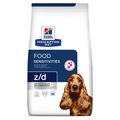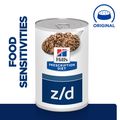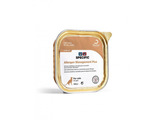Food allergies account for roughly 10% of all allergies in dogs, and even more in cats. Although these can be severe and result in uncomfortable symptoms, once you’ve identified the specific food that’s causing problems, you can pretty much resolve the issue.
It is the proteins in food that have the ability to trigger allergies, and the most common of these are beef, chicken, dairy, and even some plant-based proteins like wheat and soy. Some pets are intolerant to these ingredients and may experience mild symptoms, while others are severely allergic to them and will really suffer with their symptoms.
What are the signs of a food allergy?
Depending on the type of allergy your pet is suffering from, symptoms will vary. Largely though, they’re similar to human allergy symptoms and include hives, itching, sneezing, runny eyes, diarrhoea, gas and nausea.
 Other signs of allergies in dogs include paw chewing, excessive licking, poor coat quality, chronic ear problems such as infections and inflammation, and skin rash. Secondary infections resulting from excessive licking, itching and biting can result in nasty skin traumas, scabs and hair loss.
Other signs of allergies in dogs include paw chewing, excessive licking, poor coat quality, chronic ear problems such as infections and inflammation, and skin rash. Secondary infections resulting from excessive licking, itching and biting can result in nasty skin traumas, scabs and hair loss.
Food allergies are associated with some specific indicators, including recurrent ear infections, moderate to severe skin complaints, including itching that isn’t resolved with steroids, and year-round symptoms that aren’t heightened at certain times of year.
What should you do if you suspect your pet has a food allergy?
First and foremost, you should speak to your vet if you suspect your pet is allergic to something in its food. Your vet will review all symptoms, including details of your pet’s environment and diet, before deciding on the type of allergy your pet has, and whether or not it is food-related.
If your vet is unsure, then tests will be needed to confirm a diagnosis.
Allergy tests:
Blood tests and/or skin tests may be needed. Think about potential triggers, including environmental ones, and try to remove these from the home and other areas your pet comes into contact with.
 If the trigger is food-related, begin an elimination diet. There is no ‘one diet suits all’ approach to this and working out how best to conduct the trial will involve your vet questioning you in detail about previous and current diets, treats and any medications your pet may be taking.
If the trigger is food-related, begin an elimination diet. There is no ‘one diet suits all’ approach to this and working out how best to conduct the trial will involve your vet questioning you in detail about previous and current diets, treats and any medications your pet may be taking.
The idea of an elimination diet is to start simple and gradually introduce different foods to see which, if any, trigger a reaction. It is important to stick to this test diet and avoid treats and protein-based supplements as they may be the cause of the problem.
After diagnosis:
Once you’ve successfully identified the protein that’s causing symptoms, your vet will be able to advise you on a suitable diet going forward. You will also need to do your own research and find a food that’s free from the offending ingredient. If you need advice on choosing such a diet, please don’t hesitate to get in touch.
If you've found this article helpful, you might want to read our other related articles: Allergy related itchy skin, Skin allergies in dogs, Seasonal allergies and itchy skin, How to treat adverse food reactions in dogs, Common skin complaints in cats, Elimination diets: a simple guide to identifying a food allergy.
Written by: Hannah

